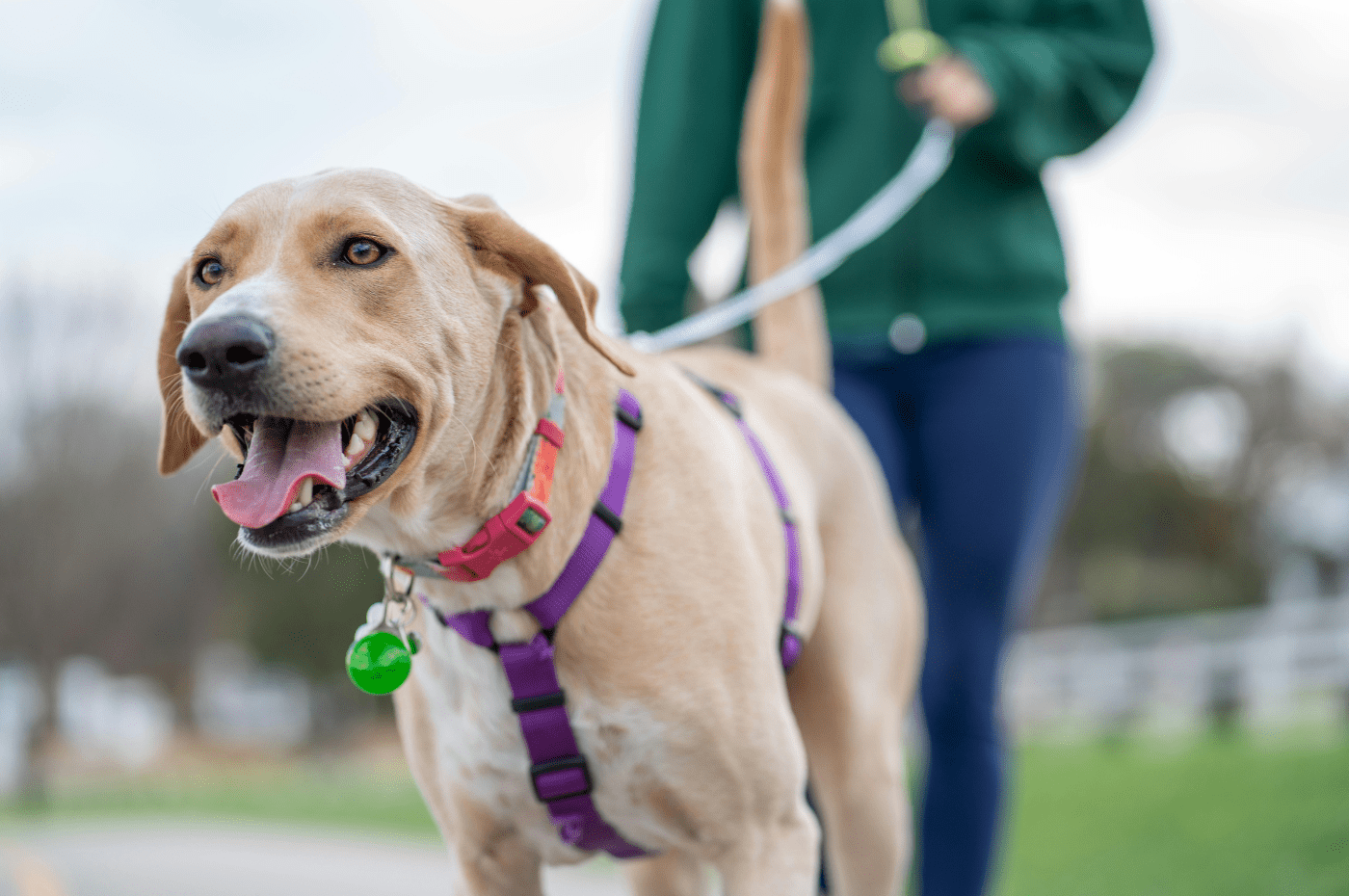Ever seen your dog walking with a wobbly gait or having difficulty lowering their head to eat from a bowl? The possible cause could be IVDD—Intervertebral Disc Disease—one of the most common causes of paralyzing back pain in dogs. But don’t worry—not all dogs require surgery, and many IVDD symptoms can be managed with proper movement exercises and pain management alternatives or medications.
IVDD is common worldwide and can be attributed to genetic conditions or may vary based on the age and breed of your dog. It is more common in older dogs, and according to The American College of Veterinary Surgeons {1}, Dachshunds alone account for over 50% of all IVDD cases.
Understanding IVDD in Dogs
What is IVDD?
IVDD is also commonly referred to as a slipped disc, herniated disc, or bulging disc. It is a neurological condition that affects a dog’s spinal cord, vertebrae, and the disc material between each vertebra. There are two types of IVDD in dogs:
- Hansen Type 1
- and Hansen Type 2
Hansen Type 1 occurs due to improper movement while jumping or landing, resulting in sharp, excruciating spinal pain. Hansen Type 2 progresses over time, with the disc material impinging on the spinal cord and nerves over months or even years. The thick fibers around the soft disc material slowly collapse, pushing upward, causing long-term pain and spinal cord compression.
Causes and Risk Factors
IVDD can be caused by certain hereditary conditions, seen largely in breeds like Dachshunds, Corgis, and Basset Hounds. Other factors, such as age-related weakness and heavy body structure, make breeds like German Shepherds and other large dogs more susceptible.
Symptoms and Diagnosis
Early diagnosis and treatment of IVDD are always ideal, as early detection increases the chances of full recovery. An MRI or a CT scan may be necessary for the veterinarian to assess the affected area. A plain X-ray may not provide full clarity, so an MRI is generally recommended to identify spinal cord compression and material in the vertebral canal.
It’s important to watch for the following symptoms in your dog’s everyday movements for timely detection of IVDD:
- Unsteady walking
- Difficulty or hesitation in performing daily activities like walking, playing, or eating
- A visibly hunched back or neck
- Difficulty posturing to urinate or defecate
- Loss of bladder or bowel control
- Paralysis—inability to walk, use limbs, change postures, or numbness in toes
Traditional Treatments for IVDD
Conventional Medical Approaches
If a dog is still able to walk and perform daily activities with relative ease, non-surgical or non-invasive methods can help manage inflammation and pain-related symptoms. Common therapies include:
- Restricted movement: You will need to adopt a strict care routine for your dog’s well-being. Rest allows the cartilage to recover and heal naturally. A crate is essential—your dog should remain crated at all times, only being carried or taken out with a sling or short leash for urination, defecation, or physical therapy when appropriate. This process may need to be followed for at least 6–8 weeks.
- Anti-inflammatory medications: Your veterinarian may prescribe specific medications after thoroughly examining the symptoms. Common medications include NSAIDs (carprofen, meloxicam, and deracoxib), gabapentin (an anticonvulsant), tramadol (an opioid used for short-term relief), and steroids (administered under veterinary guidance due to potential side effects). Injectable medications commonly used for joint pain and arthritis may also be recommended.
- Dietary plan: Managing your dog’s weight through a combination of healthy meals and supplements is crucial. A diet rich in fiber (carrots, pumpkin), minerals (fish, spinach), and antioxidants (blueberries, sweet potatoes, broccoli) is recommended, along with supplements containing omega-3 fatty acids, probiotics, and vitamins.
Limitations and Side Effects
While conventional treatments are the standard approach for IVDD, pet parents are increasingly shifting towards alternative and natural treatments due to the potential long-term side effects of traditional medications, such as:
- Gastrointestinal upset —vomiting, diarrhea, and inconsistent appetite
- Dry mouth and excessive saliva production
- Stomach ulcers — most commonly seen with NSAID use
- Skin issues — hair loss, itchiness, swelling, redness, and scabbing
- Severe liver and kidney damage — if administered long-term or in high doses
Introduction to CBD
What is CBD?
CBD (cannabidiol) is gaining popularity as a natural and effective solution for managing IVDD symptoms. The cannabis plant, found extensively in the Himalayas, contains over 118 active cannabinoids, with CBD being one of the most beneficial compounds for relieving anxiety, pain, and stress in pets.
Veterinarians worldwide are recognizing the immense potential of CBD and recommend cannabis leaf extract as a safe way to manage IVDD symptoms without chemical side effects or drug interactions.
The Endocannabinoid System in Dogs
CBD works by interacting with the Endocannabinoid System (ECS) in dogs. The cannabinoid receptors, found in muscles, intestines, and the central nervous system, interact with CBD molecules.
When a dog ingests CBD in oil form, the molecules primarily bind to these receptors in the. These receptors then communicate signals throughout various systems in the dog’s body, helping regulate appetite, stress, inflammation, and other physiological functions.
Benefits of CBD for IVDD in Dogs
CBD for IVDD in dogs works by interacting with the endocannabinoid system (ECS) to support overall health and well-being.
- Pain Relief: CBD for dog pain relief, helps reduce inflammation and discomfort by influencing the Endocannabinoid System (ECS) and lowering pro-inflammatory cytokines. Unlike NSAIDs, CBD oil for dogs provides natural pain relief for dogs without severe side effects.
- Anti-Inflammatory Properties: Anti-inflammatory supplements for dogs, like CBD, reduce spinal inflammation, relieving pressure on nerves and improving mobility.
- Managing Anxiety: Dogs with IVDD often experience stress due to restricted mobility. Managing dog anxiety with CBD helps them stay calm and comfortable during recovery.
- Neuroprotective Benefits: Research also suggests the neuroprotective benefits of CBD may support spinal cord health and reduce nerve damage in IVDD cases.
When used correctly, dog CBD products offer natural pain relief without harmful long-term effects.
How to Administer CBD Oil for Dogs with IVDD
Introducing CBD oil for dogs into their routine can be done in different ways, ensuring maximum absorption and effectiveness.
- Direct Oral Administration: The most effective method is placing CBD oil for dogs directly under their tongue for quick absorption.
- Mixing with Food: If your dog is a picky eater, mixing CBD for IVDD in dogs with their food makes administration easier and enjoyable for pets.
Safety and Side Effects of CBD in Dogs
While CBD for dogs is generally safe, pet owners should be aware of potential side effects to ensure proper usage.
- Potential Side Effects: Mild effects like dry mouth, drowsiness, or digestive upset can occur, but they are usually temporary.
- Product Quality Matters: Only use CBD products that are third-party tested, free from contaminants, and labeled for pet use.
- THC Content Awareness: THC can be toxic to dogs, so choose CBD oil for dogs with zero or minimal THC content. Qurist offers 100% THC-free DOG CBD Oil, and comes in 3 different variants, depending on the dog’s size.
Conclusion
Intervertebral Disc Disease treatment requires a combination of therapies to ensure a dog's comfort and recovery. CBD for IVDD in dogs offers natural pain relief for dogs, reduces inflammation, and helps in managing dog anxiety with CBD.
By integrating CBD for dogs with traditional therapies, weight management, and supportive care, pet owners can provide a more effective and holistic approach to treating IVDD.





Leave a comment
This site is protected by hCaptcha and the hCaptcha Privacy Policy and Terms of Service apply.